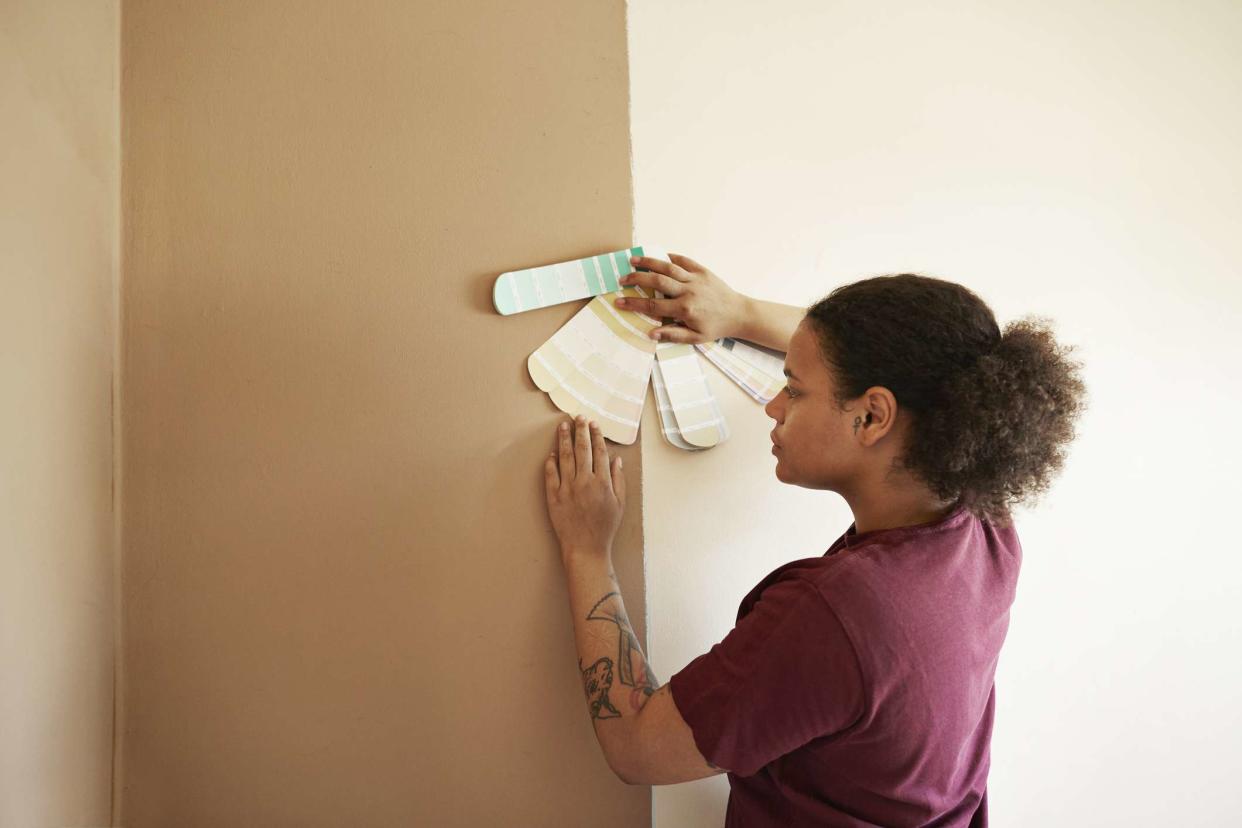How to Color Match Paint on a Wall 3 Easy Ways

Klaus Vedfelt / Getty Images
Over time, wall paint can chip, crack, or fade over time. The wall may even get damaged or need to be cut open to access pipes or wiring, leading to unsightly drywall patches. To fix these issues without straying from the ideal color and finish, you can color match the paint on the wall, then purchase a new can of paint for touch ups, repairs, or full wall updates.
Learn how to color match paint on a wall using one of three easy methods.
How to Color Match Paint With a Wall Chip
The most accurate method of color matching paint is by using a wall chip from the original wall. Start by cleaning the wall to remove fingerprints, dust, dirt, oil, and other grime so that the color of the paint is easy see, then let the wall dry completely before proceeding. Cleaning the existing wall will also help improve paint adhesion when it's time to repaint or touch up the wall.
After the wall is dry, use a utility knife to scrape off a small sample of paint from a relatively unseen area, like behind a couch or bookshelf. The sample should be about one inch in size. Take it to the nearest paint store to have the color professionally analyzed, at which point you should be able to find the paint with the right color and finish.
How to Color Match Paint With a Color Sample
Another method for color matching wall paint is by using a color sample. This method can be carried out in two different ways. The first is to take a few pictures of the original paint. Since paint can look bright and vibrant when the room is filled with light or flat and dark when there is little available light, it's important to take pictures at different times of the day. After taking the pictures, you can visually compare the picture on your device with paint swatches at the store to find the best match.
The second color matching method involving a color sample is more of a trial-and-error approach. Pick up a few color samples that seem similar to the original wall color and compare the samples with the original wall paint to determine which color is the closest option. You may want to tape some of the sample cards to the wall so that you can see how the color looks throughout the day to ensure you select the best match.
How to Color Match Paint With an App
While a visual comparison is an option, there are many paint manufacturers that have brand-specific apps designed for color matching paint, such as Sherwin-Williams, BEHR, and Valspar. There are also several apps that have multiple paint brands in case you cannot remember which brand of paint you used for the existing wall color.
However, even with an app designed for this purpose, you should scan the paint at several times throughout the day and in different lighting to ensure the app accurately identifies the paint. If possible, it's best to scan the wall paint in an area with a lot of natural light, like near a window or an open door.
How to Determine the Paint Finish
Note the finish of the paint, including flat, eggshell, satin, semi-gloss, and gloss. The finish refers to the gloss or sheen of the paint. Even if the new paint has the right color, if the finish doesn't match then the difference between the existing paint and the new paint will stand out.
The most accurate way to match the paint finish is to use the paint chip method. When the paint store is analyzing the paint chip, they will be able to determine both the color and the finish. Some apps may be able to tell the paint finish, but this isn't true of all color matching apps.
Gloss and semi-gloss will have a highly reflective surface and are regularly used in bathrooms, kitchens, and other rooms where high humidity is common. Flat and eggshell have a more matte appearance that is ideal for busy areas of the home, like the living room, den, or even the halls. Satin, which falls between matte and glossy, is often used in bedrooms and home offices.
How to Test the Color Matched Paint
Some stores will sell a small sample of paint in the selected color so you can test the paint before purchasing a full can. Apply a small patch of paint in an unseen location, like behind the furniture. For the best assessment of the new paint, you should paint at one foot by one foot patch on the primary wall of the room.
While the paint patch will stand out, it will also give you a clear view of how the paint looks in the most prominent position in the room. Just make sure to let the paint dry before comparing the new paint to the existing paint. Also, check how the paint looks in the morning, afternoon, evening, and night to ensure the paint looks as expected regardless of the lighting.
Read Next: How to Choose an Exterior Paint Color
Read the original article on The Spruce.

